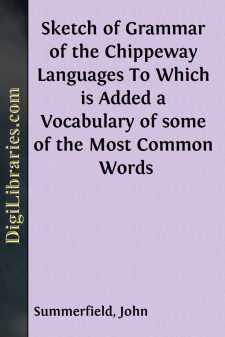Categories
- Antiques & Collectibles 13
- Architecture 36
- Art 48
- Bibles 22
- Biography & Autobiography 813
- Body, Mind & Spirit 142
- Business & Economics 28
- Children's Books 17
- Children's Fiction 14
- Computers 4
- Cooking 94
- Crafts & Hobbies 4
- Drama 346
- Education 46
- Family & Relationships 57
- Fiction 11829
- Games 19
- Gardening 17
- Health & Fitness 34
- History 1377
- House & Home 1
- Humor 147
- Juvenile Fiction 1873
- Juvenile Nonfiction 202
- Language Arts & Disciplines 88
- Law 16
- Literary Collections 686
- Literary Criticism 179
- Mathematics 13
- Medical 41
- Music 40
- Nature 179
- Non-Classifiable 1768
- Performing Arts 7
- Periodicals 1453
- Philosophy 64
- Photography 2
- Poetry 896
- Political Science 203
- Psychology 42
- Reference 154
- Religion 513
- Science 126
- Self-Help 84
- Social Science 81
- Sports & Recreation 34
- Study Aids 3
- Technology & Engineering 59
- Transportation 23
- Travel 463
- True Crime 29
Sketch of Grammar of the Chippeway Languages To Which is Added a Vocabulary of some of the Most Common Words
by: John Summerfield
Categories:
Description:
Excerpt
ADVERTISEMENT.
The following pages were written as an exercise for my leisure hours, while attending the Oneida Conference Seminary during the past winter. As it is the first attempt that, to my knowledge, has ever been made to reduce the Chippeway language to any system, it cannot be expected to be otherwise than imperfect, and perhaps may hereafter be found to be, in some respects, erroneous. It is, however, as free from errors as my present means have enabled me to make it. It has been printed at the request of my friends, by a fellow student, at his own suggestion and expense.
J. SUMMERFIELD.
Cazenovia, April 10, 1834.
SKETCH OF GRAMMAR, &c.
The Letters used in the Chippeway Language, are twenty-one, viz. A, a; B, b; C, c; D, d; E, e; G, g; H, h; I, i; J, j; K, k; M, m; N, n; O, o; P, p; Q, q; S, s; T, t; U, u; W, w; Y, y; Z, z. F, L, R, V, and X, are not used.
There are, in the Chippeway Language, ten parts of Speech, namely, the article, the noun, the pronoun, the adjective, the verb, the participle, the adverb, the preposition, the conjunction, and the interjection.
OF THE ARTICLE.
There is but one Article, used definitely both in the masculine and neuter genders, viz. Owh, the, m.; Ewh, the, n.
OF NOUNS.
A Noun is the name of any person, place, or thing; as, Eneneh, man; Kahdahnahqueeng, Kingston; metig, tree.
Nouns are of two sorts, Common and Proper.
Common Nouns stand for kinds containing many sorts, or for sorts containing many individuals under them; as, Ahwaseeh, animal; eneneh, man; kegownh, fish; penaseh, bird.
Proper Nouns are the names appropriated to individuals, as, Charles, Cazenovia, Ganges. [N.B. Proper names, with a few exceptions, are the same as in English.]
To Nouns belong gender, person, number, and case.
GENDER.
Gender is the distinction of nouns with regard to sex.
Nouns have three genders, the masculine, the feminine, and the neuter.
The masculine gender denotes males; as, Eneneh, man.
The feminine gender is applied to animals, fishes, and birds; as, Nahbak, a she bear, &c.
The neuter gender denotes things without sex; as, Wewahquon, a hat.
NUMBER.
Number is the distinction of objects as one or more.
Nouns are of two numbers, the singular and the plural.
The singular number implies but one object; as, Mahzenahegun, a book.
The plural number implies more than one; as, Mahzhenahegahnun, books.
CASE.
Nouns have three cases, the nominative, the possessive, and the objective.
The nominative case simply expresses the name of a thing, &c.; as, Owh quewesanceoobahkahmegezeh, the boy plays.
The possessive case expresses the relation of property or possession, and always ends with the letter o; as, Noosayo wegewaum, my father's house.
The objective case expresses the object of an action or of relation; as John owejeahn Charles, John assists Charles.
Nouns may be declined in the following manner:
Nom. Case,Eneneh, man.Enenewug, men.Poss. Case,Eneneho, man's.Enenewugo, men's.Obj. Case,Eneneh, man.Enenewug, men....

